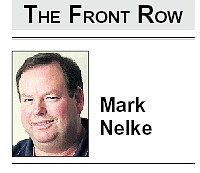THE FRONT ROW with MARK NELKE: Fans of Trail Blazers, Jazz share ‘what-ifs’ with No. 23
I rooted for the Portland Trail Blazers to beat the Chicago Bulls in the 1992 NBA Finals.
But deep down inside, I had the feeling the Bulls were going to win anyway.
A few years later, I pulled for the Utah Jazz to beat the Chicago Bulls in the NBA Finals in 1997 and ’98.
But, deep down inside, I had the feeling the Bulls were going to win anyway.
Maybe that’s just typical fandom paranoia — you love your team, but you know its faults better than anyone else.
Of course, the other team has faults, too, but their faults couldn’t be as bad as your team’s faults, right?
Then again, maybe the real reason was that the Bulls had a certain No. 23, and your team did not.
PORTLAND WAS good in those days.
Clyde Drexler. Terry Porter. Jerome Kersey. Buck Williams. Kevin Duckworth.
Cliff Robinson off the bench.
The Trail Blazers played in two NBA Finals in three seasons.
They were bullied by the “Bad Boy” Detroit Pistons in five games in 1990. Two years later, they were back with the same core group, plus Danny Ainge off the bench, but lost to the Bulls in six games.
If you believe everything you hear from “The Last Dance,” No. 23 wanted to take it to Drexler — his motivational perceived “threat” at the time.
So when No. 23 shrugs at Magic Johnson, who was courtside providing analysis for the NBC Sports telecast, after one of his six 3-pointers in Game 1, well, that shrug means something completely different than it did before you heard the “back story.”
And to think, eight years earlier, the Blazers didn’t draft No. 23 with the No. 2 overall pick because, they felt, they already had someone playing his shooting guard position in Drexler.
Hmmm ...
That was long before the current trend of “positionless basketball.”
Still, it seems like a smart organization could have found a way, even way back when, to fit the talents of both players into its offense.
And besides, Drexler wasn’t the dead-eye shooter you want in a shooting guard. He could shoot it a little bit, but he was more an athletic, run-the-floor small forward type that could play lock-down defense.
Kinda like that Pippen fellow that would join No. 23 and the Bulls three years later.
Wonder how that combination worked out?
MEANWHILE, UTAH already had a professional basketball championship under its belt.
Zelmo Beaty. Willie Wise. Ron Boone, from Idaho State. Red Robbins, a slender 6-foot-8 forward whose nickname was “The Walking 1-iron.”
Glen Combs, a shooting guard who came to one of my games when I played in a Catholic school league in seventh and eighth grade.
(OK, he didn’t come to see me; he was a family friend of one of my teammates. But still ... )
They had a shooting guard off the bench named Dick Nemelka, who some of my schoolmates thought might be related to me.
But, alas, the 1971 Utah Stars and their ABA championship will likely remain the state’s lone professional hoops title.
The Jazz moved to Salt Lake from New Orleans in 1979, took a chance on a skinny guard out of Gonzaga five years later, and found his pick-and-roll sidekick a year later.
With the two future Hall of Famers in the lineup, the Jazz were usually among the best teams in the NBA, but just seemed to be about one stud short of winning a title.
By the 1997 and ’98 seasons, Utah at least had a supporting cast capable of helping the Jazz challenge for a title.
Jeff Hornacek, Bryon Russell and Greg Ostertag rounded out the starting lineup.
The bench included Adam Keefe, Howard Eisley, Shandon Anderson, Antoine Carr and Chris Morris.
The Jazz were good enough to push the Bulls to the limit, but couldn’t prevent No. 23 from hitting the shot with 5.2 seconds left in Game 6 to give the Bulls their sixth title in eight seasons.
Of course, you wonder what might have happened in Game 7 if John Stockton’s 3-pointer at the buzzer would have carried an inch or two farther.
Or, what if No. 23 had stuck with baseball? The Houston Rockets are certainly glad he tried that sport for a year or so.
But, we’ll never know with Utah.
The chances of the small-marked Jazz ever being in that position again are slim and none, because the chances of them drafting Hall of Fame players in back-to-back years again, and being able to keep them in Salt Lake City together for nearly two decades, with the lure of free agency, are slim and none.
And ditto for the similarly small-market Trail Blazers.
Leaving fans of both franchises to wonder ...
If it weren’t for No. 23 ...
Mark Nelke is sports editor of The Press. He can be reached via email at mnelke@cdapress.com. Follow him on Twitter@CdAPressSports.

